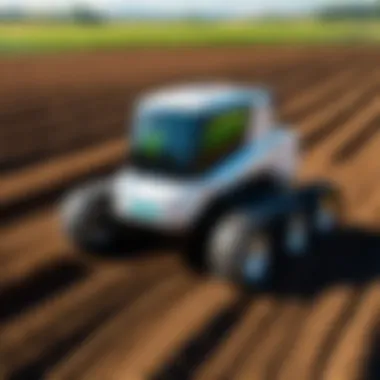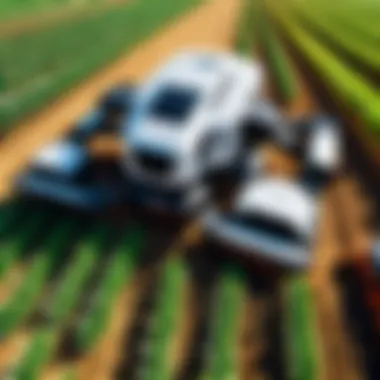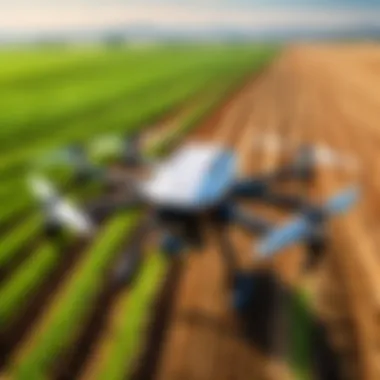Unveiling the Agricultural Revolution: The Impact of Robot Farm Equipment on Modern Farming Practices


Tech Trend Analysis
In delving into the domain of agricultural transformation, the advent of robot farm equipment stands out as a paramount evolution. The current trend reflects a shift towards greater mechanization and automation in farm operations. The implications for consumers are significant, showcasing heightened efficiency, precision, and scalability in agricultural practices. Looking ahead, future predictions envision a landscape where autonomous tractors and robotic harvesters redefine the dynamics of farming, emphasizing sustainability, enhanced productivity, and resource optimization.
Product Reviews
With a keen focus on robot farm equipment, a detailed examination of the latest innovations reveals a suite of cutting-edge features and specifications. From autonomous navigation systems to precision agriculture capabilities, these products offer a glimpse into the future of farming. Performance analysis indicates notable advancements in speed, accuracy, and operational flexibility. Pros include increased efficiency, reduced labor costs, and improved yield outcomes. However, challenges such as initial investment costs and technical dependencies may pose considerations for adoption, leading to a cautious recommendation based on specific farm requirements.
How-To Guides
Navigating the realm of robot farm equipment necessitates a foundational understanding of its operational intricacies. An introduction to the topic elucidates the fundamental principles behind autonomous agriculture and robotic technologies. Step-by-step instructions guide users through the setup, calibration, and maintenance of robot farm equipment, offering practical insights into optimizing performance. Tips and tricks enhance operational efficiency, covering aspects like data management, sensor calibration, and maintenance best practices. Troubleshooting guidelines equip users with the tools to address common issues effectively, ensuring seamless integration and utilization of robot farm equipment.
Industry Updates
In a landscape marked by constant innovation, recent developments in the tech industry continue to shape the trajectory of agricultural practices. Analysis of market trends highlights a growing emphasis on sustainable solutions, data-driven decision-making, and operational optimization. The impact on businesses and consumers is profound, with technology serving as a driver of efficiency, productivity, and environmental stewardship. As the industry evolves, integration of advanced technologies into agricultural processes promises to redefine traditional farming paradigms, establishing a new era of smart, efficient, and sustainable practices.
Introduction
Agriculture, a cornerstone of human civilization, has undergone a profound transformation over the years. From the age-old traditional farming practices to the cutting-edge technological advancements, the evolution of agriculture is a testament to humanity's perseverance and ingenuity. This introductory section sets the stage for a deep dive into the revolutionary impact of robot farm equipment in modern agricultural practices.
The Evolution of Agriculture
Traditional Farming Practices
Traditional farming practices represent the essence of agricultural heritage, embodying time-honored methods passed down through generations. These practices, rooted in manual labor and seasonal rhythms, form the bedrock of agricultural history. The hallmark of traditional farming lies in its intrinsic connection to nature and community, fostering a deep respect for the land and its capabilities. While traditional farming methods hold valuable cultural significance and promote local sustainability, they are often constrained by limited scalability and efficiency in the face of growing global demands.
Technological Advancements
Technological advancements have revolutionized the agricultural landscape by introducing innovative tools and practices to enhance productivity and sustainability. From mechanized tractors to precision agriculture techniques, technology has paved the way for optimized resource management and increased yields. One key characteristic of technological advancements is their ability to streamline farm operations, reducing manual labor and maximizing output. However, reliance on technology also raises concerns about environmental impact and the potential depersonalization of farming practices.
Rise of Robot Farm Equipment
Autonomous Tractors
Autonomous tractors represent a groundbreaking innovation in modern agriculture, offering farmers unparalleled control and precision in crop management. These advanced machines leverage cutting-edge technology to navigate fields, plant seeds, and monitor crop health autonomously. The key characteristic of autonomous tractors is their ability to operate without direct human intervention, revolutionizing farm efficiency and yield outcomes. While autonomous tractors promise increased productivity and streamlined operations, concerns regarding data security and maintenance costs linger as challenges.
Robotic Harvesters


Robotic harvesters exemplify the marriage of robotics and agriculture, streamlining the harvesting process with unparalleled speed and accuracy. These sophisticated machines are equipped with sensors and algorithms to identify ripe produce, harvest crops delicately, and minimize waste. The key characteristic of robotic harvesters is their precision in crop selection and handling, promising faster processing times and reduced labor costs. Despite their efficiency, robotic harvesters face challenges related to initial investment costs and integration complexities.
Drone Monitoring Systems
Drone monitoring systems have revolutionized farm surveillance and data collection, offering real-time insights into crop health and field conditions. These aerial devices use advanced imaging technology to detect pest infestations, track crop progress, and optimize irrigation practices. The key characteristic of drone monitoring systems is their ability to provide farmers with detailed data for informed decision-making, enhancing crop quality and quantity. However, the use of drones raises privacy concerns and operational limitations in adverse weather conditions.
Purpose of the Article
Exploring Benefits
The primary aim of this article is to unravel the multitude of benefits associated with the integration of robot farm equipment in modern agriculture. By exploring the enhanced efficiency and productivity offered by autonomous tractors and robotic harvesters, readers will gain valuable insights into the transformative power of technology in farming practices. The key characteristic of exploring benefits is its emphasis on tangible outcomes, such as increased yields and reduced labor costs, contributing to sustainable agricultural practices.
Addressing Challenges
Addressing the challenges inherent in implementing robot farm equipment is essential for a holistic understanding of its impact on agriculture. By delving into the high initial investment requirements and technological limitations associated with autonomous tractors and drone monitoring systems, this section aims to highlight potential obstacles farmers may face. The key characteristic of addressing challenges is its proactive approach to identifying and mitigating barriers to widespread adoption, paving the way for informed decision-making and strategic planning.
Considering Future Trends
Anticipating and adapting to future trends in robot farm equipment is crucial for staying abreast of technological advancements and market dynamics. By examining the integration of AI and machine learning in agricultural practices and the push for enhanced connectivity through Io T integration, readers will gain foresight into the evolving landscape of farm mechanization. The key characteristic of considering future trends is its forward-thinking perspective, emphasizing sustainability and ethical considerations in the development and deployment of robotic technologies.
Benefits of Robot Farm Equipment
Robot farm equipment plays a crucial role in revolutionizing agriculture by enhancing efficiency, productivity, and sustainability. This section delves into the key advantages offered by incorporating robot farm equipment into modern farming practices. The utilization of cutting-edge technology such as autonomous tractors and robotic harvesters has significantly transformed the agricultural landscape, paving the way for increased profits and environmental conservation. As we explore the benefits of robot farm equipment, it becomes evident that the future of farming lies in embracing these technological innovations.
Increased Efficiency
Precision Farming Techniques
Precision farming techniques involve the use of advanced technologies to optimize crop production through precise monitoring and management. These techniques contribute to maximizing yield, minimizing wastage, and improving resource utilization. The key characteristic of precision farming lies in its ability to tailor farming practices to the specific needs of each crop, resulting in optimal growth conditions. Farmers find precision farming beneficial as it helps them enhance crop quality and quantity while reducing operational costs. Although precision farming offers undeniable advantages, challenges such as initial setup costs and skill requirements need to be carefully considered.
Optimized Resource Management
Optimized resource management focuses on efficiently utilizing resources such as water, fertilizers, and pesticides to ensure sustainable farming practices. By leveraging data-driven insights and technology, farmers can allocate resources effectively, reducing waste and environmental impact. The primary benefit of optimized resource management is the ability to achieve higher crop yields with lower inputs, contributing to overall profitability. However, the integration of resource management systems may require significant investment and continuous monitoring to maintain effectiveness.
Enhanced Productivity
Faster Crop Processing


Faster crop processing involves the use of automated equipment to expedite harvesting and post-harvest activities. This approach accelerates the time-sensitive tasks involved in crop production, enabling farmers to increase their output capacity. The key characteristic of faster crop processing is its ability to streamline operations and reduce bottlenecks in the harvesting process. Farmers opt for faster crop processing methods due to their time-saving nature and potential to enhance overall farm productivity. However, challenges related to equipment maintenance and technological compatibility need to be addressed to ensure sustainable implementation.
Reduced Labor Costs
Reducing labor costs through automation is a significant advantage for farmers seeking to optimize operational expenses. Automation technologies enable tasks that traditionally require manual labor to be performed efficiently by machines, thereby reducing the need for extensive human workforce involvement. The key characteristic of reduced labor costs is the potential for long-term cost savings and increased operational efficiency. Farmers are inclined towards embracing automation to mitigate labor shortages and enhance overall farm profitability. Nonetheless, concerns related to technology reliability and training complexities may arise during the adoption process.
Environmental Sustainability
Reduced Chemical Usage
Reducing chemical usage in farming practices is essential for promoting environmental sustainability and ecosystem health. By implementing precision application methods and organic alternatives, farmers can minimize the environmental impact of agricultural activities while maintaining crop productivity. The key characteristic of reduced chemical usage lies in its contribution to preserving soil quality and biodiversity. Farmers appreciate the environmental benefits of reduced chemical usage but may encounter challenges concerning the availability and efficacy of alternative solutions.
Minimized Soil Compaction
Minimizing soil compaction through advanced equipment and practices helps preserve soil structure and fertility. By employing techniques that distribute weight evenly and reduce soil disturbance, farmers can enhance plant growth and water infiltration rates. The key characteristic of minimized soil compaction is its ability to protect soil biodiversity and enhance crop resilience. Farmers value the long-term benefits of soil conservation, yet the upfront costs and operational adjustments required for implementing soil compaction reduction measures demand careful consideration.
Challenges in Implementing Robot Farm Equipment
Mechanizing agriculture brings impressive advancements hand in hand with challenges. In a quest for efficiency and sustainability, numerous barriers confront the adoption of robot farm equipment. Delving deep into these hurdles is crucial for a nuanced understanding of reshaping agriculture. Exploring the intricacies of integrating advanced technology with traditional farming practices unveils a realm of transformative possibilities that necessitate overcoming significant challenges.
High Initial Investment
Cost-Benefit Analysis
The cost-benefit analysis stands as a pivotal decision-making tool, essential in evaluating the viability of integrating robot farm equipment. This structured approach scrutinizes the initial financial outlay against the anticipated benefits, guiding stakeholders in making informed choices. The cost-benefit analysis enables a systematic comparison, shedding light on the long-term returns versus the upfront costs associated with adopting cutting-edge technology in agriculture. Understanding the intrinsic value proposition and potential returns of investing in robot farm equipment is paramount for sustainable growth and modernization of farming practices.
Financial Barriers
Financial barriers emerge as notable roadblocks in the widespread implementation of robot farm equipment. These constraints impede the seamless transition towards automated agriculture, requiring strategic planning and resource allocation. The financial burden associated with acquiring, operating, and maintaining sophisticated robotic systems amplifies the urgency for innovative financial models and collaborative initiatives. Overcoming financial barriers demands a concerted effort from policymakers, industry stakeholders, and financial institutions to create a conducive environment for agricultural innovation.
Technological Limitations
Data Security Concerns
Data security concerns surface as critical considerations in the integration of robot farm equipment, highlighting the importance of safeguarding sensitive information and ensuring operational integrity. The protection of farm data from cyber threats and unauthorized access is paramount in maintaining a secure and resilient farming ecosystem. Embracing robust data security protocols and encryption mechanisms is imperative to instill trust and confidence in leveraging technological advancements for enhanced agricultural practices.
Interoperability Issues


Interoperability issues present significant challenges in the seamless integration of diverse technological systems within agricultural frameworks. The interoperability of different devices, applications, and platforms dictates the efficiency and effectiveness of farm automation processes. Addressing interoperability challenges requires standardized protocols, open communication interfaces, and cross-platform compatibility to foster interconnectedness and synergy among varying components of automated farming systems.
Training and Adaptation
Skill Development
Skill development emerges as a cornerstone in the successful deployment of robot farm equipment, underscoring the importance of upskilling and reskilling agricultural labor forces. Enhancing technical competencies, digital literacy, and problem-solving skills among farm workers is essential to maximize the potential benefits of automation and advanced technologies. Investing in comprehensive training programs and continuous learning initiatives empowers agricultural workers to navigate the complexities of operating and maintaining robot farm equipment with proficiency and confidence.
Workforce Transition
Navigating the transition towards automated agriculture necessitates a strategic focus on workforce adaptation and professional development. The transformation of traditional farming practices to technologically integrated systems requires a phased approach towards enabling seamless workforce transition. Facilitating knowledge transfer, offering retraining opportunities, and fostering a culture of innovation and adaptability are crucial components in ensuring a smooth and sustainable shift towards a tech-driven agricultural landscape.
Future Trends in Robot Farm Equipment
The section on Future Trends in Robot Farm Equipment plays a pivotal role in illuminating the trajectory of agricultural technological advancements. In this dynamic landscape, the integration of AI and machine learning stands out as a beacon of progress, heralding a new era of efficiency and precision. By delving into the nuances of this sector, we uncover a realm where predictive analytics and autonomous decision-making redefine the very essence of farming operations.
Integration of AI and Machine Learning
Predictive Analytics
Predictive Analytics, a cornerstone of AI integration in agriculture, embodies the essence of forward-thinking precision. Its predictive prowess allows farmers to forecast trends, optimize resources, and mitigate risks with unparalleled foresight. The essence of Predictive Analytics lies in its ability to decipher complex data sets, paving the way for informed decision-making and strategic planning. Whilst advantageous in enhancing operational efficiencies, it also comes with the challenge of data interpretation and model accuracy refinement, aspects critical for sustainable utilization within agricultural frameworks.
Autonomous Decision-Making
Autonomous Decision-Making, an integral component of AI integration, empowers farm equipment to make independent, data-driven decisions in real-time. This transformative capability streamlines operations, reduces human error, and maximizes productivity. The core of Autonomous Decision-Making lies in its adaptability and responsiveness to fluctuating conditions, ensuring optimal performance under varying circumstances. While offering a multitude of benefits, such as enhanced workflow efficiency and reduced manual intervention, it also poses challenges related to algorithm reliability and ethical implications surrounding AI autonomy within farm environments.
Enhanced Connectivity
IoT Integration
Io T Integration revolutionizes farm management by creating interconnected systems that optimize communication and data exchange. Through real-time monitoring, IoT enhances operational visibility, enabling preemptive interventions and data-driven decision-making. The crux of IoT Integration lies in its ability to transform traditional farming paradigms, fostering smart, interconnected agricultural ecosystems. Although offering unparalleled insights and efficiencies, challenges concerning data security and infrastructure vulnerabilities necessitate meticulous considerations for seamless integration into agricultural frameworks.
Real-Time Data Exchange
Real-Time Data Exchange serves as the lifeblood of modern agricultural infrastructures, enabling instantaneous information flow across interconnected devices and platforms. This real-time connectivity empowers stakeholders to access critical insights promptly, facilitating proactive responses to dynamic agricultural scenarios. The essence of Real-Time Data Exchange lies in its ability to bridge operational gaps, enhance collaboration, and optimize resource allocation. Despite its invaluable contributions to operational agility, concerns over data integrity and privacy underline the imperative of robust security measures and protocol adherence within data exchange frameworks.
Sustainability and Ethics
Green Technology Initiatives
Green Technology Initiatives spearhead sustainability efforts in agriculture, promoting eco-friendly practices and resource optimization. From renewable energy solutions to waste reduction mechanisms, these initiatives signify a progressive shift towards greener agricultural footprints. The essence of Green Technology Initiatives lies in their dual benefits of environmental preservation and operational cost savings. While heralding a new era of agricultural sustainability, challenges related to scalability and technology adoption hurdles necessitate concerted efforts from stakeholders to ensure holistic implementation and impact.
Ethical Considerations
Ethical Considerations underscore the importance of responsible AI and technology integration within agricultural frameworks, emphasizing transparent practices and user-centric methodologies. Addressing ethical dilemmas surrounding data privacy, algorithm bias, and AI influence on rural livelihoods is critical for fostering trust and sustainability within agricultural sectors. The essence of Ethical Considerations lies in their potential to shape the ethical landscape of modern agriculture, guiding ethical AI adoption and deployment practices. While advocating for ethical AI frameworks, challenges such as regulatory compliance and ethical awareness gaps highlight the need for robust ethical guidelines and continuous ethical discourse within the agricultural technology domain.



